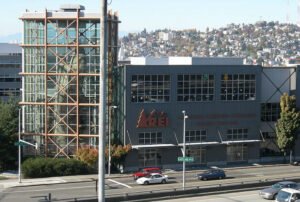
Last week, US Representative Ayanna Pressley (D-MA) advanced the political debate from merely arguing about how high the minimum wage should be to addressing a more fundamental issue: namely, that our economy, left to the whims of private business, leaves too many without work. Just as the nation’s attention has been focused on an economy in turmoil, Pressley has seized this moment to press for a new right—the right to a job.
The mechanics of Pressley’s resolution are straightforward: The federal government would create and fund jobs at the state and local level that “address national priorities as well as those put forward by local governments and community organizations—with the participation of communities impacted by structural racism, oppression, and disinvestment in the selection of projects. Projects would help to address systemic inequities that the federal government helped to create through racist policies such as redlining, urban renewal, and segregation.”
The resolution offers a selection of areas such jobs might support:
- ensuring the delivery of high-quality, professional care to children, seniors, and others in need of long-term support in family based, informal, and formal settings
- augmenting the staffing of public education and early childhood learning, including Head Start and preschool
- strengthening public afterschool programs, libraries, and recreational programs to provide lifelong learning and enrichment for people of all ages
- implementing community infrastructure and improvement projects that revitalize neighborhoods and increase accessibility, including vacant and abandoned property cleanup; street and sidewalk repair; remodeling and modernization of schools and other public community-serving facilities; and maintenance and renovation of parks, playgrounds, and public spaces
- expanding emergency preparedness, and relief and recovery from natural and community disasters, including public health, natural disasters, and environmental emergencies
- producing works of public art and documentation of American history akin to the WPA’s Federal Arts Project
- implementing environmental conservation, remediation, and sustainability initiatives and increasing the energy efficiency of buildings and our housing stock to address climate change
- rehabilitating and retrofitting our existing affordable housing stock to ensure safe, affordable, accessible, quality homes, and supporting the development of new affordable housing and social housing to address the nation’s housing crisis
Jobs created under this program would pay at least $15 an hour and provide health insurance and retirement benefits. Workers so employed would retain their ability to join unions and bargain collectively.
This past May, NPQ published an article by economists Flavia Dantas, chair of the economics department at the State University of New York at Cortland, and L. Randall Wray, emeritus professor of economics at the University of Missouri, Kansas City. In it, they outlined what a federal jobs guarantee bill might look like. One of the benefits of a federally guaranteed employment program is that it is, by design, counter-cyclical. When private sector jobs are plentiful, federal jobs will decrease. But when private sector employment falls, the federal government can pick up the slack.
Pressley’s resolution builds upon the academic intellectual framework developed by advocates like Dantas and Wray, as well as the ongoing civil rights demand for federally guaranteed jobs, which can be seen in the 1963 March on Washington for Jobs and Freedom (where the Rev. Dr. Martin Luther King, Jr. gave his “I have a dream” speech) and indeed long before that. It also draws on the work of Sadie Alexander, recognized as the nation’s first Black woman economist. Speaking at Florida Agricultural and Mechanical College in 1945 (as noted by Professor Nina Banks, blogging at the Institute for New Economic Thinking), Alexander described full employment as a way to address the nation’s economic and racial imperatives.
When labor, white or Black, native or foreign born, understands that full employment means greater purchasing power for all people, which can be obtained only by giving every man capable of holding a job the right to work, labor will have solved its own problems.
[…]
Sign up for our free newsletters
Subscribe to NPQ's newsletters to have our top stories delivered directly to your inbox.
By signing up, you agree to our privacy policy and terms of use, and to receive messages from NPQ and our partners.
The right to work is not a Black, nor a white problem but a human problem.
[…]
The more men and women who are working, the greater is the demand for goods and the more money is invested to build factories to produce goods to satisfy the demands of workers. Every man should be concerned that every other man is employed, for only in full employment is the individual laborer assured a job.
Dr. King made a similar observation. In a 1965 interview with author Alex Haley, he said, “We must develop a federal program of public works, retraining, and jobs for all—so that none, white or Black, will have cause to feel threatened. At the present time, thousands of jobs a week are disappearing in the wake of automation and other production efficiency techniques.”
The potential benefits are immense. A proposal written in 2015 by New School for Social Research professor Darrick Hamilton for Dissent observes, “The average job directly created by the program would cost about $50,000, including worker compensation. So, if all 15 million workers unemployed at the height of the Great Recession were to apply, the cost of the program would amount to roughly $750 billion.”
It’s not cheap, but with the federal government spending over $3 trillion on coronavirus relief over the past year and $1.9 trillion more under consideration, it is surely doable. Indeed, if one looks at supplemental unemployment insurance costs alone in the CARES Act ($200 billion), the December bill ($120 billion), and Biden’s proposal ($290–350 billion), the bill is over $600 billion without employing a single person. By contrast, putting 15 million people on the federal payroll would provide considerable offsetting benefits.
As Heather Long notes in the Washington Post, “The coronavirus pandemic has triggered permanent shifts in how and where people work. Businesses are planning for a future where more people are working from home, traveling less for business, or replacing workers with robots. All of these modifications mean many workers will not be able to do the same job they did before the pandemic.” And, in recent comments reported upon by the Bay State Banner, Hamilton underscores how Black people “have been disproportionately impacted by business closures during the COVID pandemic.”
Pressley—along with supporters like the Service Employees International Union, Sunrise Movement, Right to the City Alliance, and Democratic Socialists of America—believes the time for a federal jobs guarantee has finally come. Angela Glover Blackwell, founder in residence at PolicyLink, said to NewsOne, “The federal job guarantee would be a way for communities to be able to have people do the work of rebuilding community.”—Martin Levine












